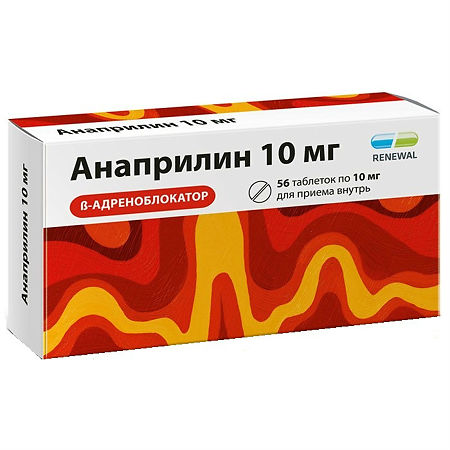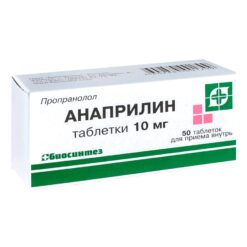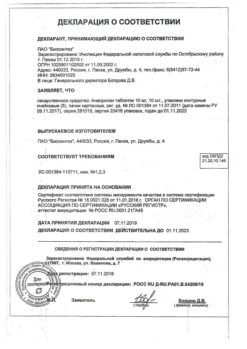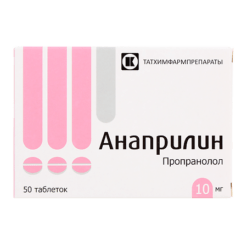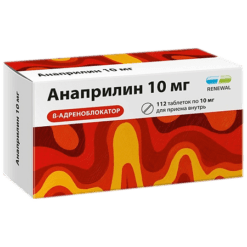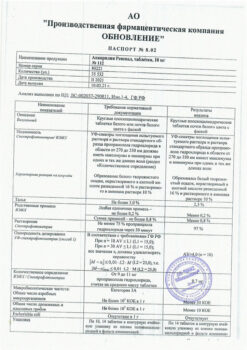No products in the cart.
Anapriline Reneval, tablets 10 mg 56 pcs
€1.00
Out of stock
(E-mail when Stock is available)
Description
Nonselective beta-adrenoblocker. It has antianginal, hypotensive and antiarrhythmic effects. By nonselectively blocking beta-adrenoreceptors (75% beta1– and 25% beta2– adrenoreceptors), reduces catecholamine-stimulated formation of cAMP from ATP, resulting in decreased intracellular calcium supply, has negative chrono-, dromo-, batmo- and inotropic effects (decreases heart rate, inhibits conduction and excitability, decreases myocardial contractility).
In the beginning of beta-adrenoblocker use, total peripheral vascular resistance increases during the first 24 h (as a result of a reciprocal increase in alpha-adrenoreceptor activity and elimination of beta stimulation2-adrenoreceptors of skeletal muscle vessels), but in 1-3 days it returns to baseline and decreases with prolonged administration.
Hypotensive effect is associated with decreased cardiac output, sympathetic stimulation of peripheral vessels, decreased activity of reninangiotensin system (relevant in patients with initial renin hypersecretion), sensitivity of aortic arch baroreceptors (there is no increase of their activity in response to decreased blood pressure) and the effect on the central nervous system. Hypotensive effect stabilizes by the end of 2 weeks of course prescription.
The antianginal effect is caused by the decrease of myocardial oxygen demand (due to the negative chronotropic and inotropic effect). Decrease of heart rate leads to prolongation of diastole and improvement of myocardial perfusion.
By increasing left ventricular end-diastolic pressure and increasing ventricular muscle fiber stretch may increase oxygen demand, especially in patients with chronic heart failure.
The antiarrhythmic effect is caused by the elimination of arrhythmogenic factors (tachycardia, increased sympathetic nervous system activity, increased cyclic AMP, arterial hypertension), decreased rate of spontaneous excitation of sinus and ectopic pacemakers and slowing of atrioventricular conduction.
The inhibition of pulse conduction is observed predominantly in antegrade and to a lesser extent in retrograde direction through the atrioventricular node and along accessory pathways. According to the classification of antiarrhythmic drugs, it belongs to group II drugs.
Decreasing the severity of myocardial ischemia – by reducing myocardial oxygen demand, postinfarction mortality may also decrease due to antiarrhythmic action.
The ability to prevent the development of vascular headache is due to a decrease in the severity of cerebral artery dilation due to beta-adrenoblockade of vascular receptors, inhibition of catecholamine-induced platelet aggregation and lipolysis, reduction of platelet adhesiveness, prevention of clotting factor activation during adrenaline release, stimulation of tissue oxygen supply and reduction of renin secretion.
The reduction of tremor on propranololol administration may be due to blockade of beta2-adrenoreceptors. Increases the atherogenic properties of the blood. Increases uterine contractions (spontaneous and induced by drugs that stimulate the myometrium). Increases the tone of the bronchi.
Pharmacokinetics
It is quickly and fairly completely (90%) absorbed when ingested and relatively quickly eliminated from the body. Bioavailability after oral administration is 30-40 % (effect of “first passage” through the liver,
microsomal oxidation); with prolonged administration it increases (metabolites are formed which inhibit liver enzymes); its quantity depends on the character of food and intensity of liver blood flow.
It is metabolized by glucuronidation in the liver. Maximum concentration in blood plasma is reached after 1-1.5 hours. It is highly lipophilic and accumulates in lung tissue, brain, kidney and heart. It penetrates through the blood-brain barrier, placental barrier and into breast milk. Binding with blood plasma proteins is 90-95%. Distribution volume is 3-5 l/kg.
Getting into the intestine with bile, it is deglucuronized and reabsorbed. Period of semiejection is 3-5 hours; it may be prolonged up to 12 hours during a course of administration. Renal excretion is 90%, unchanged less than 1%. It is not eliminated by hemodialysis.
Indications
Indications
Active ingredient
Active ingredient
Composition
Composition
How to take, the dosage
How to take, the dosage
In case of arterial hypertension, orally, 40 mg 2 times a day. If the hypotensive effect is not sufficiently pronounced, the dose is increased to 40 mg 3 times or 80 mg 2 times a day. Maximum daily dose is 320 mg.
In angina pectoris, heart rhythm disorders, the initial dose is 20 mg 3 times a day, then the dose is increased to 80-120 mg in 2-3 doses. The maximum daily dose is 240 mg.
For migraine prophylaxis, as well as in essential tremor – in an initial dose of 40 mg 2-3 times a day, if necessary, the dose is gradually increased to 160 mg/day.
In case of liver dysfunction it is necessary to reduce the dose of the drug.
In case of impaired renal function, the initial dose should be reduced or the interval between doses should be increased.
Prevention of recurrent myocardial infarction – therapy should be started between the 5th and 21st day after the myocardial infarction in a dose of 40 mg 4 times daily, for 2-3 days. Then in a dose of 80 mg 2 times a day.
In pheochromocytoma, use only with alpha-adrenoreceptor blockers.
Before surgery, 60 mg per day, for 3 days.
Interaction
Interaction
The hypotensive effect of propranolol is enhanced when combined with diuretics, reserpine, hydralazine and other hypotensive agents, and ethanol.
The hypotensive effect is weakened by nonsteroidal anti-inflammatory drugs (sodium retention and blocking of prostaglandin synthesis by the kidneys), estrogens (sodium retention) and monoamine oxidase inhibitors.
Cimetidine increases bioavailability.
Enhances plasma concentrations of lidocaine and decreases clearance of theophylline.
Concomitant administration with phenothiazine derivatives increases plasma concentrations of both drugs.
It potentiates the effects of thyrotropic and uterotonergic drugs; reduces the effect of antihistamines.
It increases the likelihood of severe systemic reactions (anaphylaxis) against the introduction of allergens used for immunotherapy or for skin tests.
Amiodarone, verapamil and diltiazem increase the severity of the negative chrono-, in- and dromotropic effects of propranololol.
Iodine-containing radiopaque drugs for intravenous administration increase the risk of anaphylactic reactions.
Phenytoin when administered intravenously, drugs for inhaled general anesthesia (hydrocarbon derivatives) increase the severity of cardiodepressive effects and the likelihood of decreased blood pressure.
Alter the effectiveness of insulin and oral hypoglycemic drugs, mask the symptoms of developing hypoglycemia (tachycardia, increased blood pressure).
Limits the clearance of xanthines (except diphylline).
The hypotensive effect is weakened by glucocorticosteroids.
The cardiac glycosides, methyldopa, reserpine and guanfacine, antiarrhythmic drugs increase the risk of developing or worsening bradycardia, atrioventricular block, cardiac arrest and heart failure.
Nifedipine can lead to a significant decrease in blood pressure.
Longens the effects of nondepolarizing myorelaxants and the anticoagulant effect of coumarins.
Tri- and tetracyclic antidepressants, antipsychotic drugs (neuroleptics), ethanol, sedatives and hypnotics increase central nervous system depression.
The concomitant use with monoamine oxidase inhibitors is not recommended due to a significant increase in hypotensive effect; a break in treatment between monoamine oxidase inhibitors and propranololol should be at least 14 days.
Non-hydrogenated ergot alkaloids increase the risk of peripheral circulatory disorders.
Sulfasalazine increases plasma concentrations of propranololol (inhibits metabolism), rifampicin shortens the elimination half-life.
Special Instructions
Special Instructions
Control of patients taking the drug should include monitoring of heart rate and blood pressure (daily at the beginning of treatment, then once every 3-4 months), recording of electrocardiogram.
In elderly patients it is recommended to monitor renal function (once every 4-5 months).
In elderly patients with increasing bradycardia (less than 50 bpm), arterial hypotension (systolic blood pressure less than 100 mm Hg), atriventricular block, bronchospasm, ventricular arrhythmias, severe liver function and/or renal impairment, the drug dose should be reduced or treatment should be stopped.
The patient should be instructed on how to count the heart rate and instructed to consult a physician if the heart rate is less than 50 bpm.
It is recommended that therapy be discontinued if depression develops as a result of taking beta-adrenoblockers.
Patients who wear contact lenses should be aware that tear fluid production may decrease with treatment.
Patients with heart failure (early stages) should use cardiac glycosides and/or diuretics before prescribing the drug.
The treatment of coronary heart disease and persistent arterial hypertension should be long-term – the drug can be taken for several years.
The treatment is stopped gradually, under a physician’s supervision: abrupt withdrawal may sharply worsen myocardial ischemia and angina, and worsen exercise tolerance. Withdrawal should be done gradually, decreasing the dose by 25% every 3-4 days over a period of 2 weeks or longer.
In thyrotoxicosis, the drug may mask certain clinical signs of hyperthyroidism (e.g., tachycardia). Abrupt withdrawal in patients with thyrotoxicosis is contraindicated because it may worsen the symptoms.
In patients with diabetes the drug is used under control of blood glucose concentration (once every 4-5 months).
Prescribe with caution in combination with hypoglycemic agents, because hypoglycemia may develop during prolonged interruptions of food intake, as well as during insulin therapy. And its symptoms, such as tachycardia or tremor, will be masked by the action of the drug.
The patient should be instructed that the main symptom of hypoglycemia during treatment with the drug is increased sweating. There is also a risk of hyperglycemia when taking oral hypoglycemic agents.
If clonidine is taken at the same time, its use can be stopped only after a few days after withdrawal of the drug.
In pheochromocytoma, it is prescribed only in combination with alpha-adrenoblockers.
The concomitant use with antipsychotic drugs (neuroleptics) and tranquilizers is contraindicated.
Drugs that reduce catecholamine stores (e.g., reserpine) may increase the effects of propranololol, so patients taking combinations of drugs should be under constant medical supervision for arterial hypotension and bradycardia.
The intravenous administration of verapamil, diltiazem should be avoided during treatment.
Cautiously use with psychotropic drugs, such as monoamine oxidase inhibitors, when used for more than 2 weeks in a course.
A few days before general anesthesia with chloroform or ether the drug should be discontinued (increased risk of myocardial depression and arterial hypotension).
In “smokers” the effectiveness of the drug is reduced.
The drug should be discontinued before testing blood and urine levels of catecholamines, normetanephrine and vanillin acid, and antinuclear antibody titers.
Any alcohol (ethanol) is not recommended during treatment – a sharp decrease in blood pressure may occur.
The consumption of natural licorice should be avoided: foods rich in protein can increase bioavailability.
Impact on the ability to drive vehicles and other mechanisms
Contraindications
Contraindications
With caution
Side effects
Side effects
Cardiovascular system disorders: sinus bradycardia, atrioventricular blockade, heart failure, palpitations, myocardial conduction disorders, arrhythmias, decreased blood pressure, orthostatic hypotension, chest pain, peripheral artery spasm, cold extremities, mesenteric thrombosis.
Digestive system disorders: dry mucous membrane of the mouth, nausea, vomiting, diarrhea, constipation, pain in the epigastric region, liver dysfunction, change in taste, ischemic colitis.
Nervous system disorders: headache, insomnia, nightmares, asthenic syndrome, agitation, depression, paresthesia, fatigue, weakness, dizziness, somnolence, confusion or short-term memory loss, hallucinations, tremor, catatonia, emotional lability, decreased rate of psychomotor reactions.
Respiratory system: rhinitis, nasal congestion, shortness of breath, bronchospasm, laryngospasm.
Metabolic disorders: hypoglycemia (in patients with diabetes mellitus type 1), hyperglycemia (in patients with diabetes mellitus type 2).
Senses: dryness of the mucous membrane of the eyes (decreased secretion of lacrimal fluid), visual acuity, keratoconjunctivitis.
Reproductive system disorders: decreased libido, decreased potency, Peyronie’s disease.
Skin disorders: alopecia, exacerbation of psoriasis, increased sweating, skin hyperemia, exanthema, psoriasis-like skin reactions, Stevens-Johnson syndrome, toxic epidermal necrolysis, exfoliative dermatitis, erythema multiforme.
Endocrine system disorders: decreased thyroid function.
Allergic reactions: skin rash, itching.
Laboratory measures: agranulocytosis, increased “hepatic” transaminase activity and bilirubin concentration.
Others: muscle weakness, back or joint pain, chest pain, leukopenia, thrombocytopenia, withdrawal syndrome.
Overdose
Overdose
Symptoms: bradycardia, dizziness or fainting, decreased blood pressure, arrhythmias, difficulty breathing, cyanosis of finger nails or palms or seizures.
Treatment: gastric lavage, administration of activated charcoal, if atrioventricular conduction is impaired – intravenous administration of 1-2 mg of atropine, epinephrine, with low effectiveness, a temporary pacemaker is placed; if ventricular extrasystole – lidocaine (Class IA drugs are not used); if hypotension the patient should be in Trendelenburg position.
If there are no signs of pulmonary edema, plasma exchange solutions are administered intravenously; if ineffective, epinephrine, dopamine, dobutamine; in convulsions, diazepam intravenously; in bronchospasm, beta-adrenergic stimulants inhaled or parenterally.
Pregnancy use
Pregnancy use
Additional information
| Shelf life | 4 years. |
|---|---|
| Conditions of storage | In a dry, light-protected place. |
| Manufacturer | Update PFC AO, Russia |
| Medication form | pills |
| Brand | Update PFC AO |
Other forms…
Related products
Buy Anapriline Reneval, tablets 10 mg 56 pcs with delivery to USA, UK, Europe and over 120 other countries.

